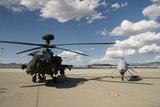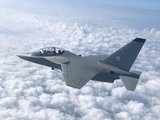UK Wildcat helicopter weapons training and digitisation reaches next stage
The new Weapons Loading System Trainer will train operators on the full range of weapons used on the AW159 Wildcat helicopter. (Photo: Leonardo)
Leonardo has introduced a Weapons Loading System Trainer (WLST) at the Royal Naval Air Station (RNAS) in Yeovilton, UK, the company announced on 7 November.
The WLST, manufactured by Pennant International, is said to be a key capability for the UK MoD’s Future Anti-Surface Guided Weapons (FASGW) programme.
The FASGW contract was initially signed in 2014. Under the programme, Leonardo will integrate, test and install the MBDA Sea Venom and Thales Martlet LMM missile systems onto RN AW159 Wildcat HMA helicopters.
The RN completed a one-month-long campaign that concluded at the end of October. During the trials, AW159 helicopters operated with seven different weapon loads configurations and test-fired the Martlet LMM missile for the first time in frontline condition.
The new WLST will train operators on the full range of weapons loading found on the AW159.
Simon Jones, VP of customer support and training at Leonardo Helicopters UK, said in a 7 November statement: ‘It [the WLST] significantly reduces the dependency on live aircraft for training and it enables greater levels of integration within a training facility.’
The delivery of the WLST is set to enhance the weapons loading training for the British Armed Forces and is part of the Wildcat Integrated Support and Training (WIST) contract.

The implementation of a tactical data link will enhance the Wildcat helicopters potency in its role as a reconnaissance platform. (Photo: UK MoD/Crown Copyright)
The 34-year WIST contract was initially signed in 2012 by Leonardo. The latest stage, a five-year, £360 million ($457.6 million) tranche delivers support service for the UK fleet of AW159 Wildcats.
It covers the period from 1 April 2022 until 31 March 2028 and includes 62 AW159 Wildcat airframes.
In other Wildcat news, the British Amy and RN have tested a new solution allowing the AW159 to share crucial information on the battlefield.
Under efforts to modernise and digitalise its platforms, the UK began trialling a tactical data link (TDL). It is a joint project by the army and navy that consists of two separate but mutually reinforcing elements – Link 16 and Bowman Data.
The British Army said the implementation of the TDL will enhance the Wildcat helicopter's potency as a reconnaissance platform.
‘What this project is seeking to do is link a battlefield reconnaissance helicopter into the Bowman Data Network, which means we’ll be able to share digital information about the positions of the enemy,’ Col Oliver Stead, 1st Aviation Brigade Combat Team, noted in a 3 November press statement.
‘The goal is to tie it into the artillery fire control system so they can then prosecute the target or to send it to other users who would do that,’ he added.
Related Equipment in Defence Insight
More from I/ITSEC 2022 Show Portal
-
![I/ITSEC 2022: HII enhances human-machine teaming training for US Army]()
I/ITSEC 2022: HII enhances human-machine teaming training for US Army
HII’s crewed-uncrewed teaming training system has been tested with the US Army’s Apache, but it can operate with any autonomous system with the right equipment to receive data.
-
![All the news from I/ITSEC and talking seabed warfare]()
All the news from I/ITSEC and talking seabed warfare
The Shephard Media news team looks at all the developments in the military training and simulation world, and discovers the trends and challenges in seabed warfare.
-
![Leonardo explores 6th-generation combat aircraft simulation at I/ITSEC 2022]()
Leonardo explores 6th-generation combat aircraft simulation at I/ITSEC 2022
Leonardo is developing the Smart Chair system in its Battle Lab that allows for advanced pilot training for multi-domain scenarios and can potentially 'replicate a sixth-generation fighter jet cockpit'.
-
![I/ITSEC 2022: Red Hawk jet trainer to be digital platform from day one]()
I/ITSEC 2022: Red Hawk jet trainer to be digital platform from day one
Boeing's T-7A Red Hawk simulator and maintenance training system will allow pilots and ground crew to train in novel ways as soon as the platforms are delivered.
-
![I/ITSEC 2022: Saab stays focused and committed to multi-site training delivery]()
I/ITSEC 2022: Saab stays focused and committed to multi-site training delivery
Saab has increased training activities across core markets, opened combined training centres and is set to grow its business further.
-
![I/ITSEC 2022: CAE to create ‘data ecosystem’ in synthetic environment and rethink approach to innovation]()
I/ITSEC 2022: CAE to create ‘data ecosystem’ in synthetic environment and rethink approach to innovation
CAE believes the future of training technologies will be fundamentally driven by bringing different industries together and no single company can exist in a vacuum - an approach that defence should adopt too.



























